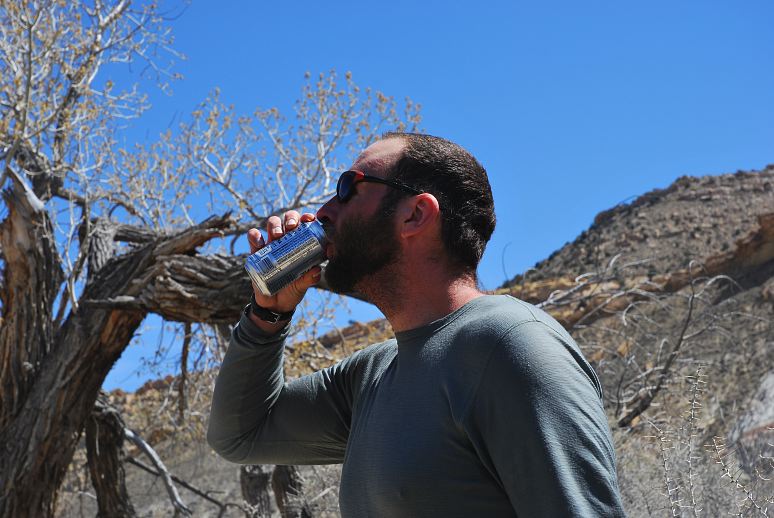Ramble On
Ramble On
Paria Canyon to Hackberry Canyon
March 26, 2009
Rain fell overnight. Snow dropped from the sky. Regular hikers would have scurried under my tarp where it was dry and safe from the falling water. Mags rolled up in his tarp like a burrito and kept sleeping. It was cold and windy, but clear, when the sun started coming up. It looked like it would be a fine morning for our last full day out.

The Paria was open and wide here, which was to be expected given the proximity of the road: The road would only go through easily accessible, non-flood prone areas. Little Dry Valley came in on the left and a bit later down Rock Springs Canyon came in also. They definitely would have saved some time yesterday, but that wasn't much to be mourned: Not coming at all would have saved a lot of time.

After a mile or so the flood plain of the Paria began to narrow into an actual gorge with soaring white sandstone walls heavily featured with all sorts of fun looking holds for climbing. If the rock was even remotely solid this would be climbing heaven. Occasionally we picked out foot tracks, some recent looking, but for the most part it was just us, cow tracks, and jeep tread marks. Apparently this must be a fun place to drive ORVs for there was a well established route through the gorge. As long as they weren't around, I didn't care a whole lot: The river would shift or flood and wipe out the tracks.
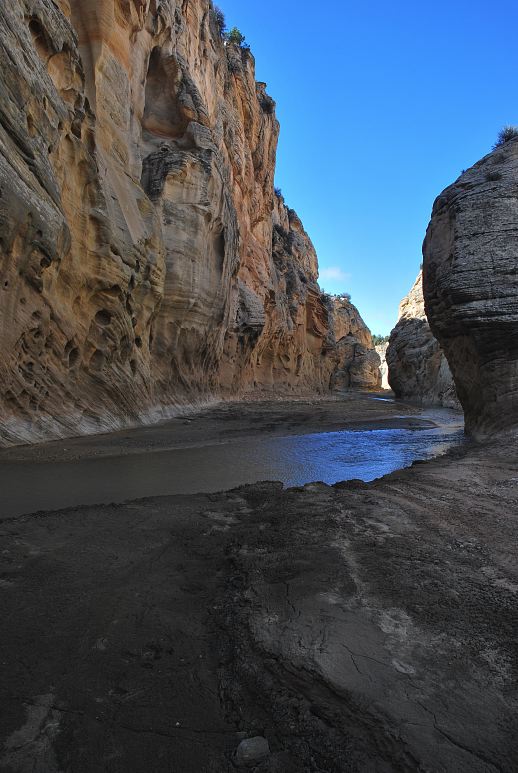
BLM lands are nearly completely unregulated and un-looked after, except when an energy or mineral company wants to extract something from the ground, in which case the BLM is happy to help. Things, I suppose, are getting better in that respect. But the price to be paid for that sort of freedom, the freedom from the inanities of national parks (camp here, walk here, play nice and we'll all get along) brings with it the need to cooperate voluntarily with diverse groups of people. Gear heads and hiker need to come to a reasonable solution to multiple use land, just as horse packers, hunters, climbers, and hippies need to work together. Sometimes this happens, other times it doesn't. The government won't do it, nor should they: That is what places like Yellowstone and Glacier and Yosemite are for.

The wind was blowing hard. There were clouds in the far distance, but it was blue overhead and nearby, yet it started to snow on us. The snow was light and powdery and was coming from somewhere far away. It is hard to see it in the below photo, but if you look carefully you can the snow, especially in the left side.
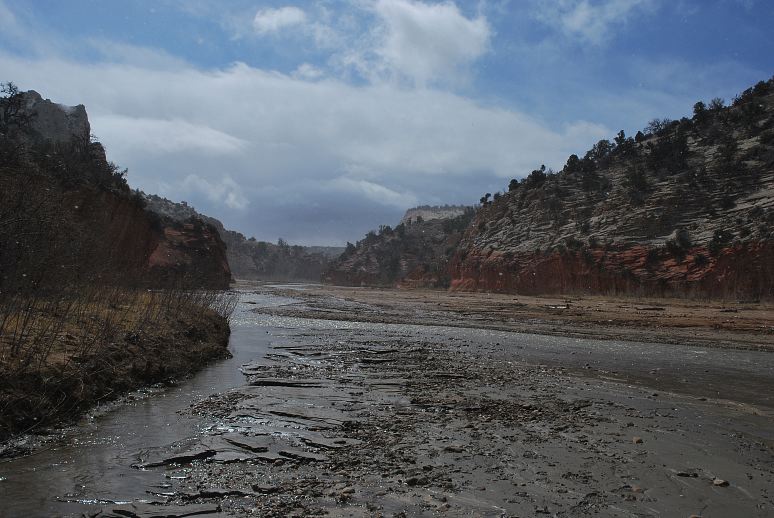
One of the great treats of hiking in southern Utah (or northern Arizona, or southwestern Colorado, or northwestern New Mexico) is the geology. I tried to get a pretty geology PhD to come out for the trip, but she had class to go to, or some such thing. As such, and not knowing anything about geology, all I could do is gawk and the freakishness of the land. Go for a walk down into the Grand Canyon and you can see rocks that millions of years old, layered on top of rocks that are even older. In Hackberry we had been following white and yellow sandstone and for the first stretch in the Paria the pattern had remained the same. But now, almost instantly, the rock began to change to the more classical red rock of Abbey Country.
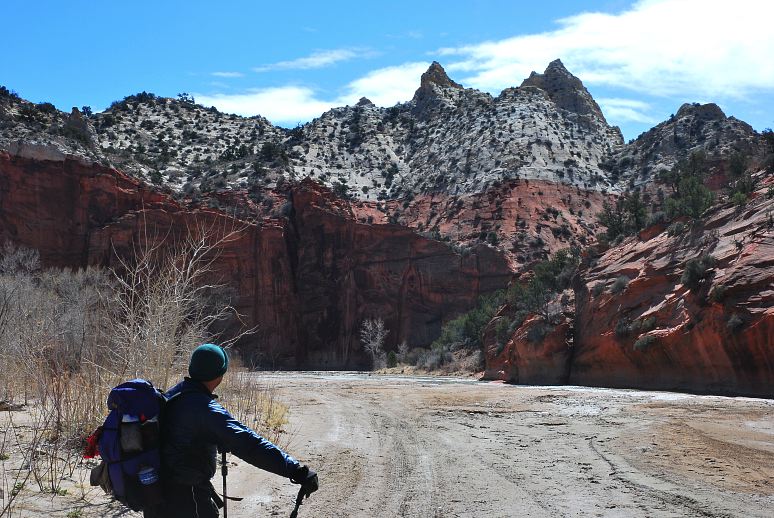
The wind had been blowing hard enough that taking a break wasn't much of an option, at least until we began to cross a stretch of sand and found a recess that was protected from the blasting wind. It made a warm, friendly spot to rest in and watch the sand blow around violently. The below photo shows the limitations of a still camera: With a camcorder of some sort, I could show the blowing sand quite dramatically.
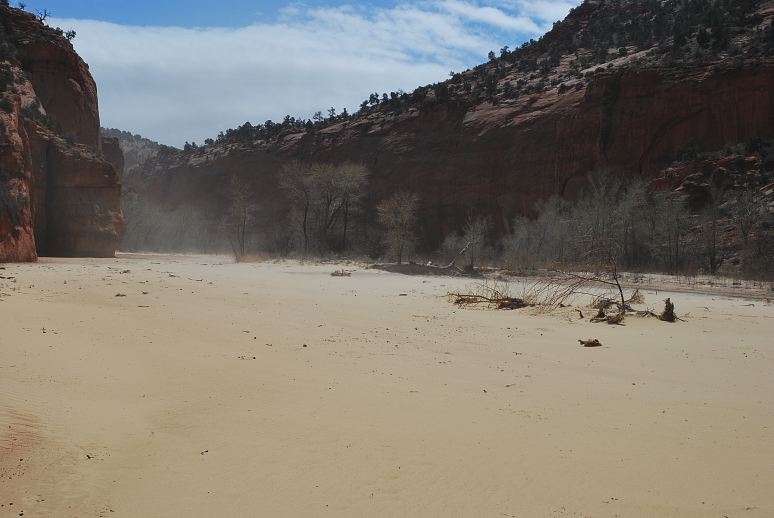
I'm a huge fan of technology that helps humans be more human. I like technology that helps me survive and thrive and that doesn't get in the way. Examples include penicillin, chainsaws, CD players, and the birth control pill. Non-examples include the Blackberry (or anything with a "smart" prefix), MTV, Twitter, frozen steamer bag vegetables, and Demetri Coupounas. Ok, so maybe Coup isn't a robot, but I wanted to get in a dig at GoLite and this seemed as good of a place as any.

Mags and I settled into a comfortable pace for walking and talking, blissfully ignorant of where we happened to be on the map. Route finding involved only following the river and we would stop where we could get some shelter from the wind and when we were tired. Mags filled me in on his impending contribution to long distance hiking philosophy called HMHD. This is a variant of the very popular, but very rare, tenet called HYOH: Hike Your Own Hike.
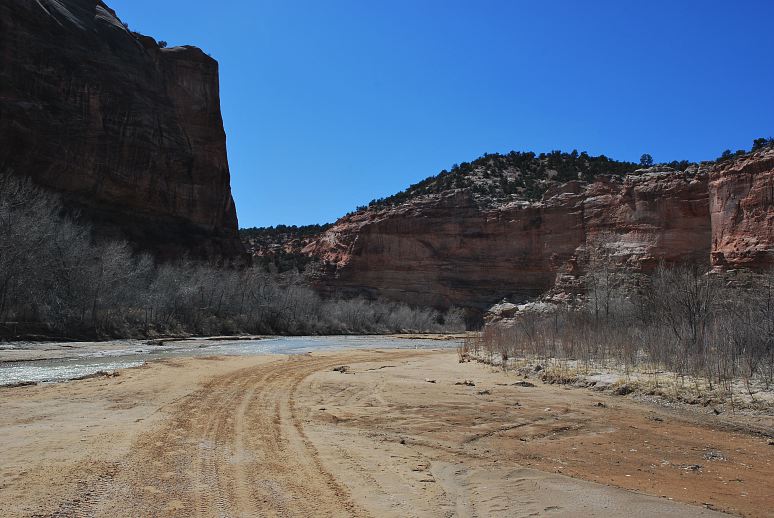
HYOH means, roughly, that you try to follow your nose as best you can and let other people follow theirs. You do not try to impose your version of hiking on another person. Indeed, you shouldn't even think that your way is right and their way is wrong. It isn't about tolerance. It is about not even seeing that there is a distinction between modes of hiking and, even, existing. HYOH is more or less extinct en masse on trails like the Appalachian. The PCT has some. The Pacific Northwest Trail has it in spades, but that's because no one hikes the PNT except a few anti-social types.
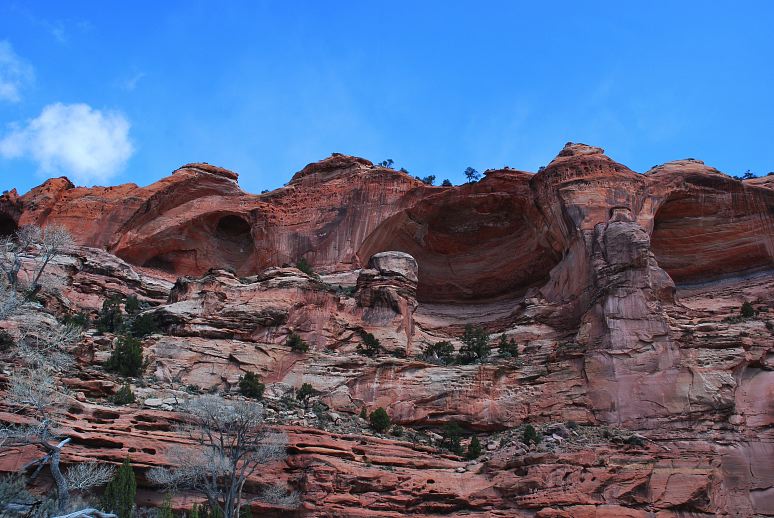
Mags' version of HYOH is much truer to the essence of reality as we find it, rather than as we hope it might be. I won't scoop Mags and claim HMHD as my own, though I'm tempted to because it is rather clever and I can never think of something clever on my own. He's got another week or two before I write something about it and reveal it to the world. Or at least the ten people who visit this website and might read about it here.

As the day wore on the wind actually picked up in strength, though in the sun it was pleasantly warm out. We continued following the river and ORV tracks, wading through the calf deep Paria when required and gawking at the pretty, but not obscene, scenery. Unlike Lower Paria, Upper Paria is more subdued than gaudy, with beauty more like the proverbial girl next door rather than that of the prom queen. The Upper Paria was where people lived and farmed (including sugar cane, apparently) and ranched, whereas the lower portion was too tight, too constrained, for any permanent settlement.

We needed to find settlement of our own for the night and finally located it in a dry wash with a rock wall to block the raging wind. The skies were clear and there wasn't much danger of our being carried off in a flood. Mags fetched water and we set up another hobo camp in the dust and red rock of the wash, safe from the howling wind just outside. There is a certain satisfaction to be had from laying on a foam pad completely exposed to the elements, watching trees close by quake from the wind, yet being well protected by a natural barrier.
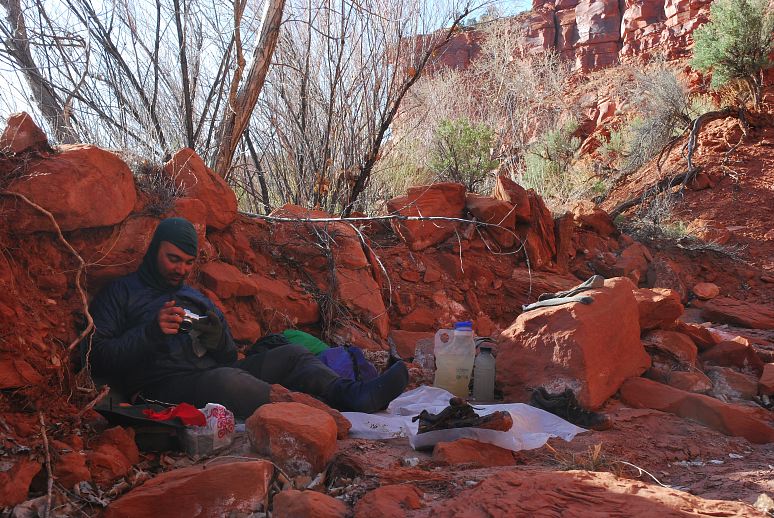
Cocktails were mixed and dinner prepared for this, our last night in the open. Mags was lucky enough not to have to go back to work and was instead heading out to southern Arizona to hike 100 miles along the Arizona Trail with another friend. At some point he would need to look for work again, but wasn't terribly concerned. Again, a central benefit of a light weight lifestyle is low stress. I, on the other hand, was facing a long drive back to Lakewood and the start of a new term. New students, new classes, and another three months until the summer arrived.

I learned a few years ago, painfully, the futility of killing time. Living in misery for 8.5 months during the bulk of the year in order to living royally for 3.5 months of the summer is not a good long term plan. It is better to be happy and content for all twelve months. It is better to have activities and pursuits and friends that one can take enjoyment from, true enjoyment, for the whole year. But sometimes plans and projects are so tempting that it is easy to get lost in the anticipation of the event. And so I found myself looking upon the spring as a burden to be endured until the better times of the summer might arrive. The silliness of this is obvious, but it happens nonetheless. But for now I had a patch of desert sand, a warm and protected place to spend the night, the stars overhead, and a cocktail in hand. Right now, everything was perfect and tomorrow would be another day.
The wind shifted overnight and the temperature dropped into the teens, perhaps lower with wind chill. Mags and I had also chosen the spot in the canyon that would get sunlight latest in the morning. It took a long time to actually get out of the sleeping bag and into the open air. Putting on my frozen trail runners was a painful activity, equaled only wading through the frigid Paria. Although the water thawed the shoes, it also turned my feet numb almost instantly and for the next minute or so it felt like I was walking on pins as my the blood went back into my feet.
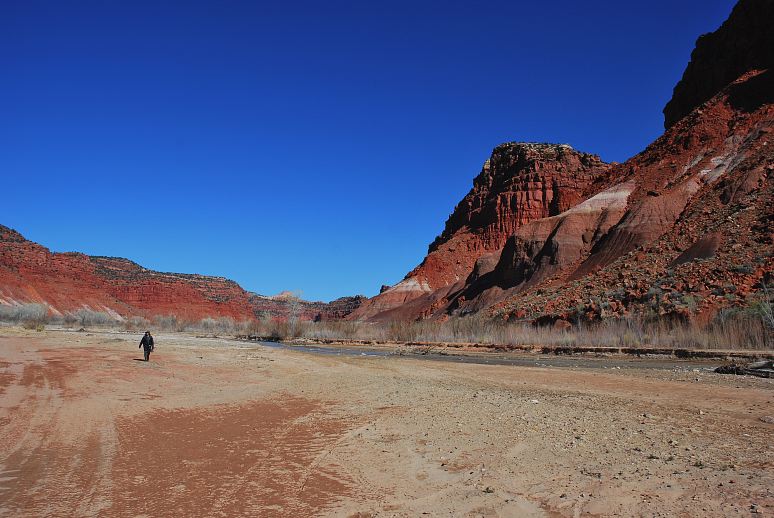
We had a short hike today, perhaps three or four hours over maybe 10 miles. I had day hiked this area last spring with Andrew before our backpack in Buckskin and Lower Paria and knew what to expect here. The old townsite for Paria was located not far from where we passed, but there was not much to see there, especially as the old movie set that was used for filming The Outlaw Josie Wales had been removed a few years ago. The rock began to change once again.

I had really hoped to have Stephanie along for the trip so that she could explain the geology of the area to us. She's also a lot easier on the eyes than Mags is. As such, Mags and I had to wander along the Paria in blissful ignorance as to the meaning of the transition in rock.

Beyond the old townsite the canyon narrowed quickly, bringing us through a formation called the Box, but what this was wasn't entirely clear to me. We waded the Paria and on the other side was open, warm sunshine and entirely different rock, both in coloration and in texture. It was warm enough to finally shed some of the clothing that I had been constantly for the last few days.

A quick check of the map and a look at the land gave us the right direction to Mags' truck and a cooler full of beer. The now just damp Hackberry wasn't far off, its waters running under the sand where as just a mile or so would put us back at the start, where the water was flowing freely. In the below photo you can see some of the dramatic rock formations. The other side of them the rock is classic Abbey country red rock: Blocky, dramatic, with arches and moons and other neat, eroded formations. This side was quite different and the transition was rapid. Neat stuff.
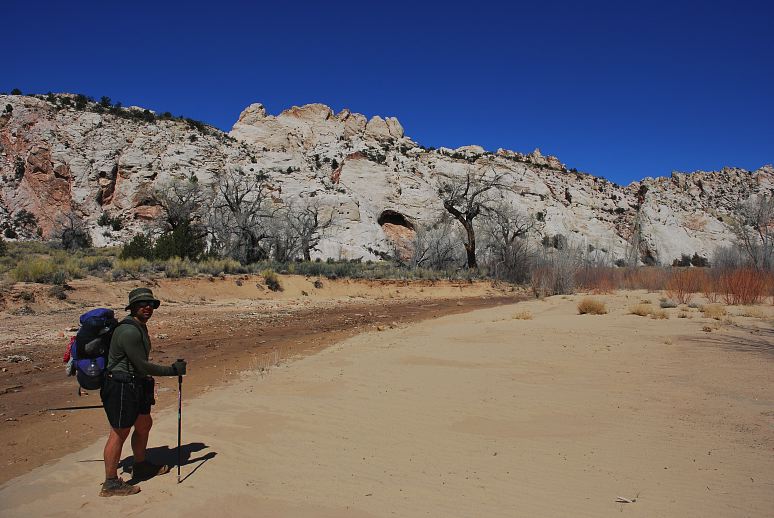
We followed the Hackberry for a bit, then cut cross country when it started twisting and turning too much, though not before Mags found a bull whip and showed off his cow herding skills. A gorge forced us from the sage fields onto Cottonwood Wash road, but only a few hundred yards from where the truck was parked at the trailhead. Inside the beer in the cooler was icy cold and the first thing we did was pop a top.
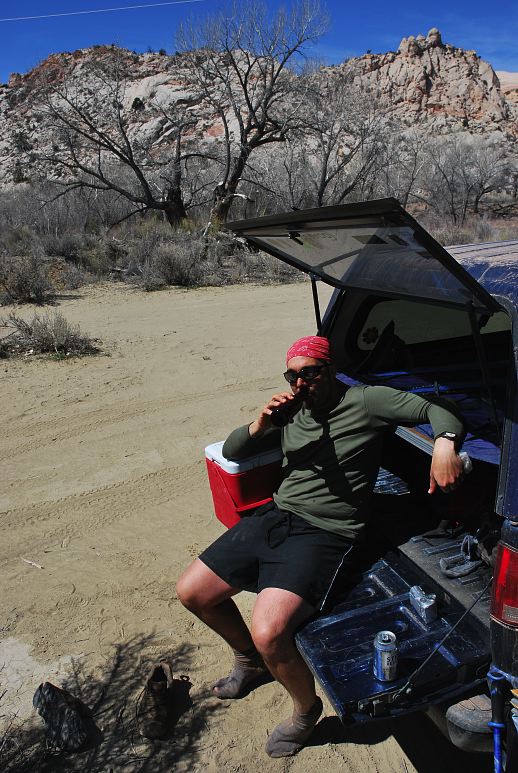
Our trip was over and tomorrow we'd be going our separate ways, Mags to Arizona and me back to the winter in Lakewood. The Springtime was almost here, though for me it would hold off a little while longer. No matter. It would get to me eventually. It was inevitable. Until then all I could do was remember the good times that were had and ponder a future in which I had developed enough for it to be Spring all year round. That, too, was inevitable.
